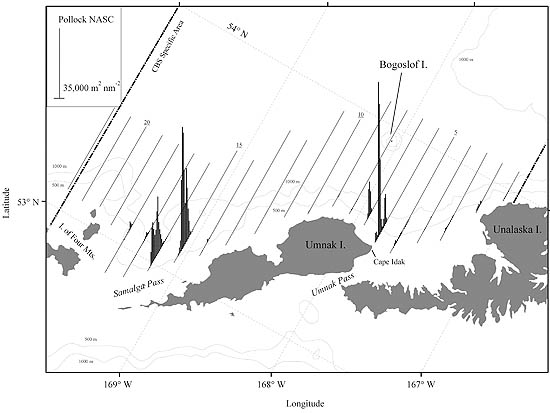

|
| Error processing SSI file |
|
||
Midwater Assessment & Conservation Engineering (MACE) ProgramWinter Surveys in the Gulf of Alaska and the Southeast Aleutian Basin  Figure 3. Relative backscattering (NASC) (m2 nm-2)
attributed to pollock observed to within 0.5 m off bottom along tracklines surveyed during the 9-19
February 2005 echo integration-trawl survey of the Shumagin Islands and Sanak Trough in the
Gulf of Alaska. Scientists from the Midwater Assessment and Conservation Engineering (MACE) Program conducted echo integration-trawl (EIT) surveys of the Shumagin Islands and Sanak Trough in the Gulf of Alaska 9-19 February (Fig. 3 above), and of the Bogoslof Island area in the southeastern Aleutian Basin, 7-12 March 2005 (Fig. 4 below) aboard the NOAA ship Miller Freeman. The surveys provided data on the abundance, distribution, and biological composition of spawning walleye pollock (Theragra chalcogramma). Echo integration and trawl data were collected 24 hours per day. A total of 16 trawl hauls were made in the Shumagin Islands and Sanak Trough regions, and 19 trawl hauls were conducted in the Bogoslof Island region. With a few exceptions, pollock dominated the trawl catches. The most notable exceptions were rockfish captured during the southeastern Aleutian Basin survey between Umnak Island and Unalaska Island.  Figure 4. Relative backscattering (NASC) (m2 nm-2)
attributed to pollock observed to within 0.5 m off bottom along tracklines surveyed during the 7-12
March 2005 echo integration-trawl survey of the southeastern Aleutian Basin near Bogoslof Island.
Transect numbers are underlined and the Central Bering Sea (CBS) Specific Area boundary is marked. For the Gulf of Alaska surveys, the densest pollock
aggregations were located off Renshaw Point in the Shumagin Islands, and
in the southern part of Sanak Trough (Fig. 3). The pollock size
composition was unimodal in each of the two areas. Most of the pollock
in the Shumagin Islands measured between 46 and 48 cm fork length (FL),
and most of the pollock in Sanak Trough were between 48 and 49 cm FL.
The unweighted maturity composition of female pollock with lengths
greater than 40 cm, was 64% mature, 5% spawning, and 23% post-spawning
(spent) in the Shumagin Island area, and 70% mature, 7% spawning, and
17% spent in Sanak Trough. By Denise McKelvey
By Alex De Robertis
By Craig Rose |
|
AFSC Quarterly Research Reports Jan-Mar 2005 ContentsFeature ABL Reports NMML Reports RACE Reports REFM Reports Items Quarterly Index Quarterly Home |
|
|
||
|
|
||